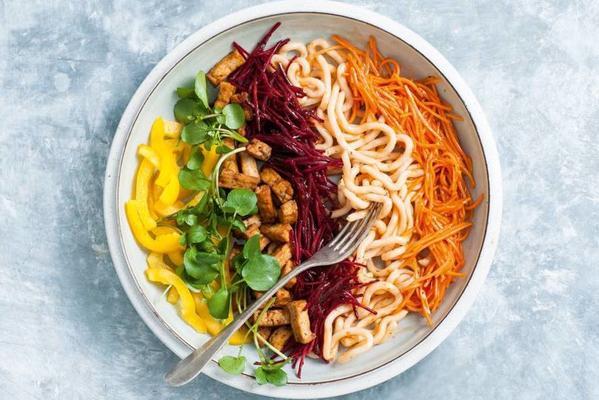Ketogenic (very low carb) diet: an introduction
-
A ketogenic diet is a special form of the low-carbohydrate diet. With a ketogenic diet, the consumption of carbohydrates is limited and the consumption of fats is broadened to such an extent that ketones are produced by the liver and that the metabolism shifts from carbohydrate burning to fat burning. The ketogenic diet is often used as an easy way to lose weight, because you can lose weight without feeling hungry, but it also has other health benefits, such as diabetes.
The basis
-
The starting point for a ketogenic diet is to reduce the consumption of carbohydrates to less than 50 grams per day, preferably even less than 20 grams per day. So it is a form of low-carb diet. A rule of thumb is the 5/35/60 rule, which means 5% of the daily energy intake from carbohydrates, 35% from proteins and 60% from fats. Note: this concerns the energy supplied, not the weight of the food. Protein and carbohydrates contain 4 KCalories per gram, fat contains 9 KCalories per gram. The diet is also known as Low Carb High Fat, LCHF for short.
Adjustment of the body
-
When your body goes into ketosis, the glycogen stores in the liver are first used up. Then your body switches to fat burning instead of carbohydrate burning. Because your body is not used to this, your body has to adapt to burning fat for energy. During this transition, all kinds of effects can occur such as headaches, dizziness, fatigue and other flu-like symptoms. On average this will take about three days, but it varies from person to person.
-
 11 minMain dishpeanut oil, tofu stir-fry cubes finely seasoned, stir fry sauce sweet and sour, thick noodles, carrot julienne, beetroot julienne, yellow bell pepper, watercress,rainbow salad with tofu
11 minMain dishpeanut oil, tofu stir-fry cubes finely seasoned, stir fry sauce sweet and sour, thick noodles, carrot julienne, beetroot julienne, yellow bell pepper, watercress,rainbow salad with tofu -
 45 minMain dishRed cabbage, mild olive oil, quinoa plus, forest outing, lemon, sesame oil, soy sauce less salt, Bio Today tahini white in pot, tap water,grilled red cabbage with quinoa salad
45 minMain dishRed cabbage, mild olive oil, quinoa plus, forest outing, lemon, sesame oil, soy sauce less salt, Bio Today tahini white in pot, tap water,grilled red cabbage with quinoa salad -
 30 minDessertBrie, Roquefort, port salut, gruyere, Camembert, walnut, garlic, thyme, honey, grape, baguette, Red onion, red grape, raisins, Red wine, Red wine vinegar, Brown sugar,generous cheese plate with onion marmalade
30 minDessertBrie, Roquefort, port salut, gruyere, Camembert, walnut, garlic, thyme, honey, grape, baguette, Red onion, red grape, raisins, Red wine, Red wine vinegar, Brown sugar,generous cheese plate with onion marmalade -
 30 minDessertFull Milk, whipped cream, macaroon, custard powder, vanilla sugar, sugar, protein, amaretto, almond liqueur, basic recipe cooking pears,macaroon pastry with casserole
30 minDessertFull Milk, whipped cream, macaroon, custard powder, vanilla sugar, sugar, protein, amaretto, almond liqueur, basic recipe cooking pears,macaroon pastry with casserole
What to Avoid
-
Bread, pasta, rice, sugar, candy, sugary soft drinks, chips, beer and fruit (yes, "healthy" fruit is packed with sugar)
What to eat
-
Vegetables (but no beans and peas), eggs, meat, fish, natural fats such as butter (no margarine, etc.), nuts, cheese and full-fat yogurt and cottage cheese.
Alcohol
-
To get your body used to the ketogenic state, it is advised not to drink alcohol for the first two months. After that, alcohol can exceptionally be drunk, but this will always mean that the weight loss will stop until all alcohol has been burned. Never pack carbohydrate-containing drinks such as beer, sweet wines, breezers, and liqueurs. Instead, have red wine, dry white wine, whiskey or vodka.
-
 5 minDrink without alcoholbananas, cool fresh apple-pear raspberry juice, Soy drink vanilla,soy fruit shake
5 minDrink without alcoholbananas, cool fresh apple-pear raspberry juice, Soy drink vanilla,soy fruit shake -
 20 minMain dishsauerkraut, sticking potato, liquid baking product, half-to-half minced, Spice meatballs, pineapple, olive oil, liquid baking product,gratin sauerkraut dish with minced meat
20 minMain dishsauerkraut, sticking potato, liquid baking product, half-to-half minced, Spice meatballs, pineapple, olive oil, liquid baking product,gratin sauerkraut dish with minced meat -
 40 minMain dishlemongrass, fresh ginger, Red peppers, onions, tomato cubes, fresh cod fillet, coriander, oil, ground turmeric (koenjit), coconut milk, salt,fish in creamy coconut sauce
40 minMain dishlemongrass, fresh ginger, Red peppers, onions, tomato cubes, fresh cod fillet, coriander, oil, ground turmeric (koenjit), coconut milk, salt,fish in creamy coconut sauce -
 15 minSide dishsweet potato, soft goat cheese, egg, spring / forest onion,stuffed sweet potato with egg
15 minSide dishsweet potato, soft goat cheese, egg, spring / forest onion,stuffed sweet potato with egg
Counting calories
-
The first weeks it can be very insightful to count calories. But it is much more important to listen to your body. If you are not hungry, don't eat! It doesn't matter if it happens to be dinner time. If you are hungry, eat. Try not to eat all day long, if you do eat more fats. These provide a satiated feeling. When you count calories, you know if you are on the right track. After a few weeks, you can rely on your body's signals and you can avoid calorie counting.
Example daily menu
-
Breakfast 2 eggs with bacon, possibly supplemented with some spinach
Lunch
-
Salad of vegetables of your choice, chicken or tuna, boiled eggs, salad dressing or dressing of your choice (read the label: choose a salad dressing or dressing with little sugar and high fat)
-
 20 minMain dishTasty vine tomato, (olive oil, fresh basil, onion, garlic, Parmigiano Reggiano, zucchini spaghetti, pumpkin spaghetti, mini buffalo mozzarella,lukewarm pumpkin and zucchini spaghetti
20 minMain dishTasty vine tomato, (olive oil, fresh basil, onion, garlic, Parmigiano Reggiano, zucchini spaghetti, pumpkin spaghetti, mini buffalo mozzarella,lukewarm pumpkin and zucchini spaghetti -
 15 minSide dishtraditional olive oil, curry powder, wheat flour, coconut milk, sambal oelek, chicken broth tablet, water, fresh mango,curry sauce with mango
15 minSide dishtraditional olive oil, curry powder, wheat flour, coconut milk, sambal oelek, chicken broth tablet, water, fresh mango,curry sauce with mango -
 30 minMain dishtraditional olive oil, lean ground beef, frozen Mexican wok vegetables, salsa sauce mild, taco shell, grated young cheese, creme fraiche,Mexican vegetable in tacos
30 minMain dishtraditional olive oil, lean ground beef, frozen Mexican wok vegetables, salsa sauce mild, taco shell, grated young cheese, creme fraiche,Mexican vegetable in tacos -
 95 minMain dishmaize chicken, lemon, coarse sea salt, pepper, extra virgin olive oil, garlic, thyme, zucchini, tomatoes (small to), black olives without pit,provençal chicken with zucchini and tomatoes
95 minMain dishmaize chicken, lemon, coarse sea salt, pepper, extra virgin olive oil, garlic, thyme, zucchini, tomatoes (small to), black olives without pit,provençal chicken with zucchini and tomatoes
Dinner
-
A piece of fatty meat, fish or poultry of your choice. Not breaded.
Snack
-
Cubes of cheese and / or slices of sausage (salami, cervelate)
Read the labels
-
Many foods contain (hidden) carbohydrates. Fortunately, most labels state how much of the various macronutrients (carbohydrates, proteins, fats) there are per 100 grams. Estimate how much you will eat and whether this fits within a ketogenic diet. Fresh foods only have an ingredient declaration, often not broken down by macronutrients. Note the other names for sugar such as dextrose, fructose, sucrose, honey, molasses syrup, sugar syrup, fruit juice concentrate, etc. Other carbohydrates include potato flour, corn flour, thickener, etc.
Other Health Benefits
-
The scientific basis for the other health claims is still limited. Many people report improvement of various complaints after switching to a low-carbohydrate or ketogenic diet. The effects on improving health can vary from person to person. Many people report a strong reduction or disappearance of inflammatory reactions and skin complaints. Stomach complaints also disappear in many people who switch to a ketogenic diet. And because the bacteria population in the gut is favorably affected, it could also cause anxiety relief and depression. However, no proper research has been done on this.
Diabetes
-
Many type II diabetics report an improvement in their blood levels and a reduction in the need for insulin. If you follow the diet faithfully, type II diabetes may even disappear. Medical supervision and check-ups are recommended, as results may vary from person to person.